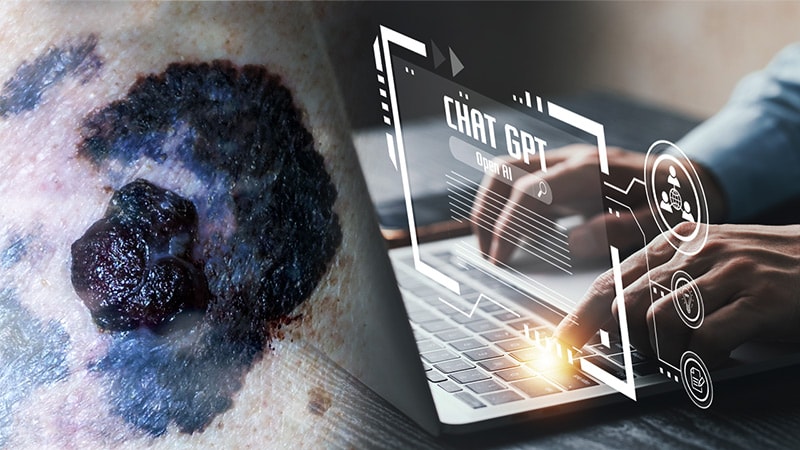Evaluating ChatGPT's Ability to Diagnose Melanoma from Dermatoscopic Images
Основные понятия
ChatGPT's performance in diagnosing melanoma from dermatoscopic images is significantly below that of approved AI algorithms, posing high risks for missing melanomas or incorrectly classifying benign lesions as malignant.
Аннотация
The content discusses a study that explored the performance of ChatGPT Vision in diagnosing melanoma from dermatoscopic images. Key points:
In September 2023, a new feature was added to ChatGPT that allows analysis of images, including those obtained through dermatoscopy.
The study used 100 melanocytic lesions, including 50 melanomas and 50 benign nevi, from the International Skin Imaging Collaboration archives.
Considering the first diagnosis provided by ChatGPT Vision, the sensitivity was 32%, specificity was 40%, and overall diagnostic accuracy was 36%.
The correct diagnosis was in the top three of the differential diagnoses with a sensitivity of 56%, specificity of 53%, and precision of 55%.
Regarding ChatGPT's ability to differentiate between malignant and benign lesions, the sensitivity, specificity, and precision were 46%, 78%, and 62%, respectively, for the diagnosis deemed most likely and 78%, 47%, and 62% for the top three diagnoses.
The study is limited by the small number of lesions used, the absence of dysplastic lesions, and the lack of consideration of essential data such as anatomical site, nevus type, and melanoma thickness.
The results show that ChatGPT Vision's performance is significantly below that of approved AI algorithms for diagnosing melanoma, posing high risks for clinical use.
Tell Me, ChatGPT, Is This a Melanoma?
Статистика
The sensitivity, specificity, and overall diagnostic accuracy of ChatGPT Vision in diagnosing melanoma from dermatoscopic images were 32%, 40%, and 36%, respectively, considering the first diagnosis provided.
The correct diagnosis was in the top three of the differential diagnoses with a sensitivity of 56%, specificity of 53%, and precision of 55%.
Regarding ChatGPT's ability to differentiate between malignant and benign lesions, the sensitivity, specificity, and precision were 46%, 78%, and 62%, respectively, for the diagnosis deemed most likely and 78%, 47%, and 62% for the top three diagnoses.
Цитаты
"The risk for missing a melanoma and incorrectly classifying a lesion as malignant is too high to use ChatGPT in clinical practice."
"ChatGPT is not sufficiently effective for the diagnosis of melanoma, even if it can at least help describe images. Or should we say not yet sufficiently effective?"
Ключевые выводы из
by Marie-Line B... в www.medscape.com 07-10-2024
https://www.medscape.com/viewarticle/tell-me-chatgpt-this-melanoma-2024a1000co7
Дополнительные вопросы
What additional data or features could be incorporated to improve ChatGPT's performance in diagnosing melanoma from dermatoscopic images?
To enhance ChatGPT's performance in diagnosing melanoma from dermatoscopic images, several additional data points and features could be incorporated. Firstly, including data on the anatomical site of the lesion could provide valuable context, as certain areas of the body are more prone to melanoma. Incorporating information on the type of nevus, such as whether it is a common nevus or a dysplastic nevus, would also be beneficial as dysplastic nevi have a higher risk of developing into melanoma. Furthermore, integrating data on the thickness of the melanoma could aid in more accurate diagnoses, as thicker melanomas are typically more advanced and require different treatment approaches.
How do the limitations of this study, such as the small sample size and lack of dysplastic lesions, affect the generalizability of the findings?
The limitations of this study, particularly the small sample size and absence of dysplastic lesions, significantly impact the generalizability of the findings. With only 100 melanocytic lesions used, the study may not capture the full spectrum of variations seen in clinical practice. The lack of dysplastic lesions is a notable gap since these lesions are crucial in melanoma diagnosis due to their higher malignant potential. As a result, the findings may not accurately represent real-world scenarios, limiting the applicability of the study's conclusions to broader populations.
Given the current limitations, what other potential applications or use cases could ChatGPT have in the field of medical imaging and skin lesion analysis?
Despite its limitations in diagnosing melanoma, ChatGPT could still have valuable applications in the field of medical imaging and skin lesion analysis. One potential use case could be in assisting with preliminary screenings or triaging of skin lesions, where ChatGPT could help prioritize cases based on the likelihood of malignancy. Additionally, ChatGPT could be utilized for educational purposes, providing information on different types of skin lesions and aiding in the training of medical professionals. Moreover, ChatGPT could support research efforts by quickly analyzing large datasets of dermatoscopic images to identify patterns or trends that may not be immediately apparent to human observers.
0
